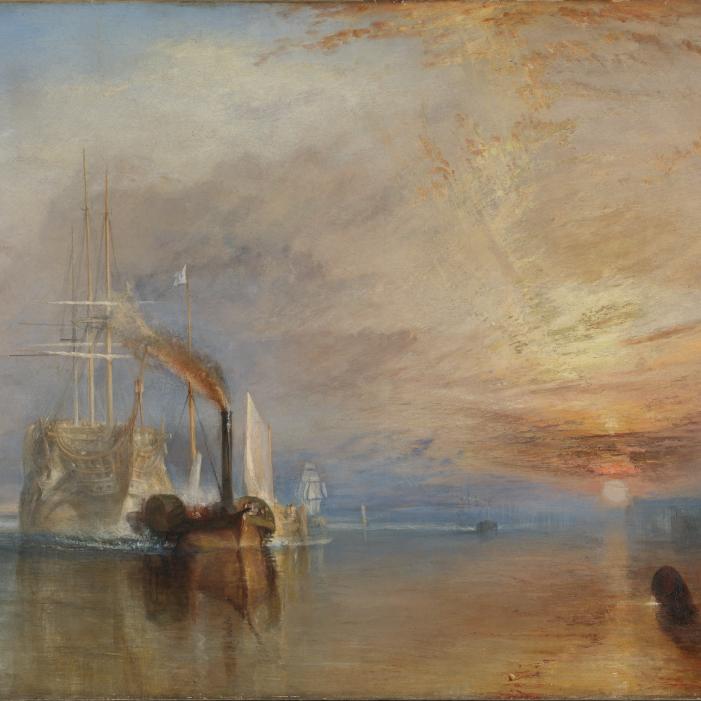Turner on Tyneside
One of the UK’s most iconic paintings, Turner’s “The Fighting Temeraire”, is just one of the attractions at the Laing Art Gallery’s summer show. Gail-Nina Anderson gets a sneak preview.
Forget the ever-rising train fares to London – this summer the National Gallery has chosen twelve “partner venues” each of which will get the loan of one really top of the range painting around which further related loans will be curated to form a pretty nifty (not to say world class) temporary exhibition. And yes, the Laing will not only be part of this, but will be displaying Turner’s “The Fighting Temeraire, tugged to her last berth to be broken up, 1838”, an oil painting first exhibited at the Royal Academy in 1839 and bequeathed by the artist to the nation in 1851. And in case you want some icing on top of that, in 2020 this work was included on the new £20 banknote (along with the artist's 1799 self-portrait), having already been voted the nation's favourite painting in a poll organised by BBC Radio 4's Today programme in 2005.
So what’s so special about a seascape showing a past-its-prime ship being pulled along by a grubby little steam driven tugboat? Just that, I guess - a subject which fuses patriotism, nostalgia and a touch of sadness for glory days now passing with a real, news-worthy event and an awareness of modern engineering - then transcends that already powerful mixture of ideas in its dazzlingly brilliant visual treatment of the subject. Turner was at the top of his game by 1838, a well-established master in the British art world who had developed his own, idiosyncratic mode of landscape painting, equally effective in oils or watercolour. His style of loose brush work, where irrelevant detail is suppressed by the suffusion of atmospheric light and shadow, is often cited as a precursor to Impressionism, but can also be seen as a form of Romanticism, infusing his depicted scenes with an intensity of emotional potential.
And that’s what happens here, not least because he chose not to paint the event as it really happened. HMS Temeraire (known to her crew as Saucy) was a 98-gun second-rate ship of the line of the Royal Navy. Launched in 1798, she served during the French Revolutionary and Napoleonic Wars, mostly on blockades or convoy escort duties. She fought only one fleet action, the Battle of Trafalgar, where her heroic action aiding Nelson’s Victory added “fighting” to her popular name and reputation. By 1838 her working days were over and, stripped of all cannons, hardware, masts and rigging she was sold off and hauled by two tugboats to the breakers’ yard at Rotherhithe, on Turner’s beloved Thames. (Those little tugs, by the way, the Samson and the London, were manufactured on Tyneside.) We don’t honestly know whether the artist observed this final journey at first hand, but in any case, his depiction transforms it into an elegiac scene where the passage of time, in curious tune with the primal elements, is celebrated as much as mourned. His version restores the masts, a tenuous framework of pale timber that convey a ghostly, almost Gothic air, setting this main motif surprisingly off-centre to the left of the composition, distanced from the (here single) tugboat as though fading into the mists of memory. That sturdy modern tug, however, isn’t the villain of the piece so much as the energy of the present, with its sharper, darker shape belching flames echoed in the sunset as it drives confidently forward into its own, almost palpable, reflection.
And if contemplating this sublime manifestation gets too intense, you can happily distract yourself with the selection of other Turner works, on paper as well as canvas, which have been brought together for the exhibition, contextualising and extending the associated ideas about art, industry and land/seascape. These include the Tate’s “Peace – Burial at Sea” a nocturnal tribute to the artist David Wilkie who had died during a voyage, which features some of Turner’s most dramatic lighting effects. The riverscapes of Whistler, another Thames lover, will also be represented in the show, along with works by L. S. Lowry and Tacita Dean, but I suspect it will be the stark photographic imagery of Chris Killip that sets up the most potent currents of comparison. Killip (1946 – 2020), co-founder of the Side Gallery, said that it was only later he came to realise that during the time he spent as part of the Amber Film & Photography Collective in Newcastle during the 1970s and 80s, that he had unknowingly recorded the de-industrialisation of north-east England, witnessing a rapid change to the industrial landscape and responding through his camera to the transformation and its aftermath. Enterprise, energy, decay and memory – these are the threads that run through Killip’s photographs as well as Turner’s canvasses. These concepts are called up by such powerful images, but never quite pinned down, as our shifting responses to them help shape the way we view our own world.
Turner: Art, Industry & Nostalgia, Laing Art Gallery, Newcastle, 10 May – 7 September, laingartgallery.org.uk
Sign Up To Little Crack

